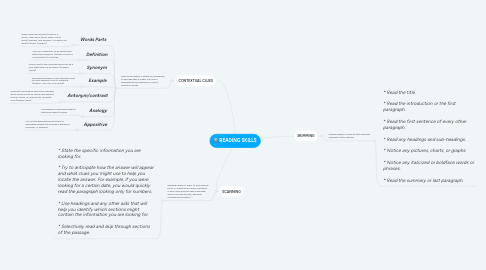
1. SCANNING
1.1. Reading rapidly in order to find specific facts. In scanning you have a question in your mind and you read a passage only to find the answer, ignoring unrelated information.
1.1.1. * State the specific information you are looking for. * Try to anticipate how the answer will appear and what clues you might use to help you locate the answer. For example, if you were looking for a certain date, you would quickly read the paragraph looking only for numbers. * Use headings and any other aids that will help you identify which sections might contain the information you are looking for. * Selectively read and skip through sections of the passage.
2. CONTEXTUAL CLUES
2.1. Hints found within a sentence, paragraph, or passage that a reader can use to understand the meanings of new or unfamiliar words.
2.1.1. Words Parts
2.1.1.1. Break down the different parts of a word—base word (word stem or root word), prefixes, and suffixes—to figure out what it means. (Disable)
2.1.2. Definition
2.1.2.1. Look for a definition or an explanation within the sentence. (Disable is limit of a movement or activities.
2.1.3. Synonym
2.1.3.1. Words next to the unknown word can be a clue that there is a synonym. (Disable= Impair)
2.1.4. Example
2.1.4.1. Providing examples of the unknown word can give readers a clue to meaning. (Disable : lost one of his hand)
2.1.5. Antonym/contrast
2.1.5.1. Opposite information about the unknown word can be offset by words and phrases such as unlike, as opposed to, different from.(Diasble~Able)
2.1.6. Analogy
2.1.6.1. Comparisons of the word help to determine what it means.
2.1.7. Appositive
2.1.7.1. ook for the grammatical structure of appositives which can provide a definition, synonym, or example.
3. SKIMMING
3.1. reading rapidly in order to get a general overview of the material
3.1.1. * Read the title. * Read the introduction or the first paragraph. * Read the first sentence of every other paragraph. * Read any headings and sub-headings. * Notice any pictures, charts, or graphs. * Notice any italicized or boldface words or phrases. * Read the summary or last paragraph.
